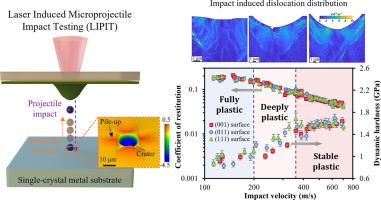Acta Materialia ( IF 9.4 ) Pub Date : 2023-02-26 , DOI: 10.1016/j.actamat.2023.118807 Jizhe Cai , Claire Griesbach , Savannah G. Ahnen , Ramathasan Thevamaran

|
A clear understanding of the dynamic behavior of metals is critical for developing superior structural materials as well as for improving material processing techniques such as cold spray and shot peening. Using a high-velocity (from ∼120 m/s to 700 m/s; strain rates >107 1/s) micro-projectile impact testing and quasistatic (strain rates: 10−2 1/s) nanoindentation, we investigate the strain-rate-dependent mechanical behavior of single-crystal aluminum substrates with (001), (011), and (111) crystal orientations. For all three crystal orientations, the dynamic hardness initially increases with increasing impact velocity and reaches a plateau regime at hardness 5 times higher than that of at quasistatic indentations. Based on coefficient of restitution and post-mortem transmission Kikuchi diffraction analyses, we show that distinct plastic deformation mechanisms with a gradient dislocation density evolution govern the dynamic behavior. We also discover a distinct deformation regime—stable plastic regime—that emerges beyond the deeply plastic regime with unique strain rate insensitive microstructure evolution and dynamic hardness. Our work additionally demonstrates an effective approach to introduce strong spatial gradients in dislocation density in metals by high-velocity projectile impacts to enhance surface mechanical properties, as it can be employed in material processing techniques such as shot peening and surface mechanical attrition treatment.
中文翻译:

由冲击引起的梯度位错密度引起的金属动态硬度演变
清楚地了解金属的动态行为对于开发优质结构材料以及改进冷喷涂和喷丸等材料加工技术至关重要。使用高速(从 ∼120 m/s 到 700 m/s;应变率 >10 7 1/s)微弹冲击测试和准静态(应变率:10 -21/s) 纳米压痕,我们研究了具有 (001)、(011) 和 (111) 晶体取向的单晶铝基板的应变率依赖性机械行为。对于所有三个晶体取向,动态硬度最初随着冲击速度的增加而增加,并在硬度比准静态压痕高 5 倍时达到平台状态。基于恢复系数和事后传输 Kikuchi 衍射分析,我们表明具有梯度位错密度演化的不同塑性变形机制控制着动态行为。我们还发现了一种独特的变形机制——稳定的塑性机制——它超越了深度塑性机制,具有独特的应变率不敏感微观结构演化和动态硬度。



























 京公网安备 11010802027423号
京公网安备 11010802027423号